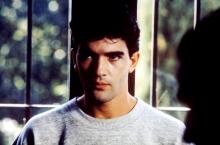These notes on Law of Desire (La Ley Del Deseo) were written by Erica Moulton, PhD candidate in UW Madison’s Department of Communication Arts. A 35mm print of Law of Desire will screen in our Sunday Cinematheque at the Chazen salute to Pedro Almodóvar on Sunday, September 24 at 2 p.m. in the Chazen Museum of Art.
How do you want to be loved? That is the question that drives the narrative of Pedro Almodóvar's striking 1987 film, Law of Desire, his sixth feature film to be released in Spain. This question, of not only "who do you desire" but "how do you wish to be desired by others", torments the film's protagonist, Pablo Quintero, a director who finds himself at a crossroads both personally and professionally following the release of his new feature. Apart from his creative burdens, including his struggle to define his voice in the Spanish cultural marketplace, Pablo is also reeling from the rejection of his advances by his lover Juan. His transgender sister Tina (played by Almodóvar regular, Carmen Maura) further complicates matters by hoisting her daughter, Ada, on Pablo to look after. Finally, a new figure enters Pablo's life in the form of the obsessive Antonio (Antonio Banderas), whose sudden, intense burst of feeling for Pablo throws everyone's lives into violent disarray.
Law of Desire sees Almodóvar continue to develop his unique blend of high melodrama and psycho-sexual thriller, which is always underscored by a strong sense of Spanish cultural identity. Like Matador, his fifth feature, Almodóvar presents a vibrant and beautifully shot film, drawing inspiration from the films of Douglas Sirk and Alfred Hitchcock, but always adding his own irreverent spin on the material. For his directorial efforts, he was awarded the 'best new director' prize by the Los Angeles critics association. Certainly, Law of Desire was the film that provided Almodóvar with his biggest international platform yet in his career, and critics and the press alike were eager to seize on the film's autobiographical aspects, quickly labeling Almodóvar a 'gay director'.
At the time of its release, Spanish critics, in particular, were quick to label it an autobiography, with one declaring that Almodóvar was 'stripped bare' in the film. Even Almodóvar was willing to admit that he drew inspiration from his own life in telling Pablo's story. The close relationship of Pablo and Tina in the film mirrors his own close connection to his brother Augustín, who acts as a producer on Almodóvar's films and runs his production company, appropriately called El Deseo (The Desire). The film's subplot about Tina confronting a priest who sexually abused her as a child was influenced by Almodóvar's own experiences as a young boy in the church (a topic that Almodóvar would return to again in Bad Education). In his book Desire Unlimited: The Cinema of Pedro Almodóvar, scholar Paul Julian Smith argues that Law of Desire "clearly offers itself as an auteurist work, one in which the figure of the director informs and transforms the audience's reception of the film" (80). While his films can all stand on their own, it is helpful to understand Law of Desire within the context of Almodóvar's life and experience in his native country of Spain.
Almodóvar's celebrity on the global stage was just emerging in 1987, but with his films, he was drawing on a personal history that was all too familiar to his fellow Spaniards. Born in 1949, he grew up in the shadow of the Franco regime, a harsh totalitarian government that sought to control every aspect of its citizens' lives, especially their religious practices, and enforced strict Catholic codes of behavior. After Franco's death in 1975, a countercultural movement known as La Movida Madrileña emerged in retaliation, with participants in the movement embracing previously taboo practices like drug use and punk culture. Almodóvar was an active part of this movement, and drew inspiration from the punk scene in Madrid for his first film Pepi, Luci, Bom. He never fully lost the punk ethos, even as his filmmaking became more sophisticated, and throughout his career, there is always a strong sense of subversive playfulness that infuses his films.
Law of Desire is a wonderful example of how Almodóvar is able to balance the subversive elements in his films with the melodramatic. In a discussion of how his films blur genre lines at AFI Fest in 2011, reported by Indiewire, Almodóvar stated: “Melodrama was the first genre I saw as a child, housewives would listen to it on the radio. I also loved musicals. I’ve been a moviegoer since I was a child, and I started making movies as a projection of my life… I mix genres because during the day I pass through a lot of genres. Sometimes even science-fiction! Comedy, noir. These are mixed in life, so they are mixed in my movies.” As Law of Desire deftly cycles between genres, Almodóvar crafts a film about desire and being desired that is as thrilling and mysterious as the real life experience. When asked about making the film, Almodóvar likened the process to a disastrous love affair, saying “when you're madly in love with a boy and someone asks you: 'Do you like him?', you don't know. All you know if that that's the only thing in your head right now, and that includes every imaginable state of mind, from delight to despair." (Smith 80)
Almodóvar’s description perfectly captures the experience of watching Law of Desire for the first time—it’s an intoxicating combination of attraction and befuddlement. You will delight and you will despair. What more could a filmmaker hope to achieve!










